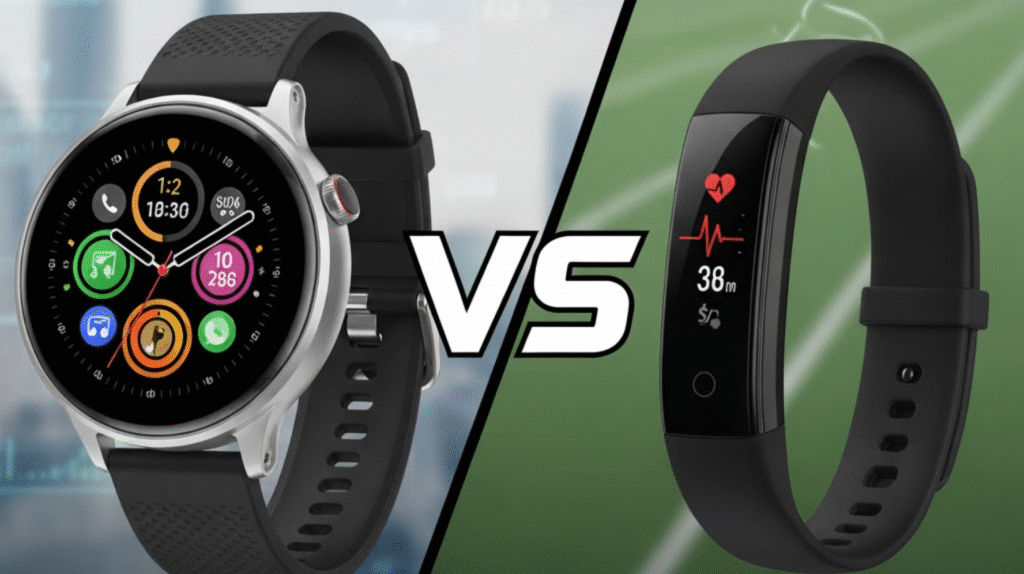Choosing between a smartwatch and a fitness band isn’t just about tracking steps. These wearables serve different purposes, cater to distinct lifestyles, and vary significantly in functionality.
Smartwatches offer comprehensive features like app integration, call handling, and advanced sensors, while fitness bands focus on core health tracking with exceptional battery life.
Understanding their differences helps you select a device that aligns with your daily routine, fitness goals, and budget. Whether you’re an athlete seeking detailed metrics or someone wanting basic activity monitoring, this guide reveals everything you need to make an informed decision.
Differences Between Smartwatches and Fitness Bands
The fundamental distinctions between these devices extend far beyond appearance.
Design and Portability
Fitness bands feature slim, lightweight profiles that make them ideal for 24/7 wear. Their minimalist design feels barely noticeable on your wrist. Smartwatches come with larger displays and bulkier cases, providing better screen visibility but adding weight.
The size difference matters when sleeping or exercising. Fitness bands typically use narrow straps and compact sensors, while smartwatches resemble traditional timepieces with substantial bezels.
Display Technology
Smartwatches incorporate AMOLED or OLED screens ranging from 1.4 to 1.9 inches. These high-resolution displays show detailed information, support touch navigation, and enable app interactions. Fitness bands feature smaller screens, often 0.5 to 1.6 inches, displaying basic metrics.
The screen quality impacts usability. Larger smartwatch displays make reading notifications effortless, while fitness bands prioritize battery conservation over screen real estate.
Operating Systems
Smartwatches run full operating systems like Wear OS, watchOS, or proprietary platforms. These systems support third-party app installations, regular updates, and ecosystem integration. Fitness bands use simplified firmware focused on health tracking.
This fundamental difference determines functionality. Smartwatches can run navigation apps, music streaming services, and productivity tools, while fitness bands stick to fitness-related features.
Health and Fitness Tracking Capabilities
Both devices monitor health, but depth and accuracy vary considerably.
Basic Activity Monitoring
Fitness bands excel at step counting, distance tracking, and calorie estimation. They’re built specifically for accurate fundamental measurements. A quality fitness band with heart rate monitoring provides continuous pulse tracking throughout the day.
Smartwatches offer identical basic tracking plus additional sensors. The difference lies in specialization versus versatility. Fitness bands focus resources on perfecting core metrics.
Advanced Health Sensors
Modern smartwatches include ECG capabilities, blood oxygen monitoring, and skin temperature sensors. These features help detect irregular heart rhythms and monitor overnight health changes. Premium models offer stress tracking through electrodermal activity sensors.
Fitness bands typically lack these advanced sensors, maintaining focus on activity and heart rate. The sensor difference impacts health insights. Smartwatches provide medical-grade measurements suitable for health condition monitoring.
Sleep Analysis
Both device types track sleep duration, stages, and quality. Fitness bands deliver accurate sleep data with minimal charging interruption due to extended battery life. Smartwatches offer deeper analysis, including respiratory rate and overnight SpO2 trends.
However, frequent charging requirements may disrupt consistent sleep tracking. Sleep tracking accuracy depends on sensor quality rather than device type. High-end models in both categories provide reliable sleep insights.
Smart Features and Connectivity
This category reveals the most significant divide between device types.
Notification Management
Fitness bands display incoming calls, texts, and app alerts. You can read notifications but rarely respond directly. Smartwatches enable full interaction with notifications, including replying to messages, answering calls, and dismissing alerts.
This interactive capability transforms how you manage communications. Smartwatches essentially become smartphone extensions. You can handle urgent matters without reaching for your phone.
App Ecosystem
Smartwatches support downloadable applications from dedicated app stores. Install navigation apps, music streaming services, payment platforms, and productivity tools. Fitness bands lack app store access, limiting functionality to pre-installed features.
This restriction keeps fitness bands focused but less versatile. The app ecosystem matters for customization. Smartwatches adapt to your specific needs through specialized applications.
Voice Assistants and Calls
Premium smartwatches integrate voice assistants like Siri, Google Assistant, or Alexa. Make hands-free commands, set reminders, and control smart home devices. Many models include speakers and microphones for direct wrist calls.
Fitness bands rarely offer voice features beyond basic music control. Voice functionality enhances convenience. Smartwatch users can manage tasks while cooking, exercising, or driving.
Battery Life and Charging
Power management differs drastically between these wearables.
Typical Battery Duration
Fitness bands deliver 7 to 21 days per charge depending on features and usage. Models like the Amazfit Band 7 reach 18 days with standard use. Smartwatches typically require daily to every-three-day charging, with most lasting 24 to 72 hours.
The battery gap reflects processing power and screen technology differences. Extended battery life reduces charging frequency. Fitness bands suit users who dislike routine charging.
Power-Draining Features
Always-on displays consume 50-70% more battery on both device types. Continuous GPS tracking significantly reduces runtime, limiting outdoor workout sessions. Smartwatches drain faster due to app notifications, cellular connectivity, and processor demands.
Fitness bands conserve power through simpler operations and smaller screens. Understanding power drains helps optimize settings. Disabling unnecessary features extends usage between charges.
Charging Technology
Modern smartwatches adopt fast-charging systems, reaching 50% in 15-20 minutes. This technology mitigates shorter battery life through quick top-ups. Fitness bands typically use standard charging, taking 1-2 hours for full batteries.
The charging speed difference affects daily routines. Fast charging proves convenient for forgetful users. Brief charging sessions maintain smartwatch functionality throughout the day.
Price Ranges and Value
Cost considerations significantly influence purchasing decisions.
Entry-Level Options
Budget fitness bands start around $25 to $60, offering basic tracking without displays. Models like the Xiaomi Smart Band provide comprehensive features at $60. Entry-level smartwatches begin near $150, delivering limited smart features and basic health tracking.
The price difference reflects complexity. Budget-conscious buyers find excellent value in mid-range fitness bands. They deliver core functionality without premium costs.
Mid-Range Selections
Quality fitness trackers in the $100-$200 range include GPS, advanced heart monitoring, and extended battery life. Popular models like the Fitbit Charge 6 cost $160. Mid-range smartwatches ($200-$400) offer comprehensive health sensors, app ecosystems, and smartwatch functionality.
This price tier balances features and affordability. Mid-range devices suit most users. They provide sufficient features without unnecessary premium additions when you check out top deals on gadgets and accessories.
Premium Devices
High-end smartwatches exceed $400, featuring cellular connectivity, premium materials, and professional athletic features. Models like the Apple Watch Ultra reach $800. Premium fitness bands rarely exceed $200, maintaining focus on specialized tracking.
The price premium buys luxury materials and advanced capabilities. Premium smartwatches target enthusiasts who value cutting-edge technology. Most users find mid-range options sufficient.
Use Cases and User Preferences
Different lifestyles benefit from specific device types.
For Casual Fitness Enthusiasts
People walking daily and monitoring basic activity thrive with fitness bands. These devices track steps, calories, and heart rate without overwhelming users. Their simplicity appeals to those wanting health awareness without complexity.
Fitness bands suit individuals prioritizing battery life and affordability. Casual users rarely need advanced smartwatch features. Simple tracking encourages consistent health monitoring.
For Serious Athletes
Athletes requiring detailed performance metrics benefit from smartwatches. Advanced GPS tracking, training load analysis, and recovery metrics optimize performance. Features like multi-band GPS and barometric altimeters provide professional-grade data.
Serious athletes often choose sport-focused smartwatches over general fitness bands. Athletic goals demand comprehensive tracking. Smartwatches deliver actionable insights for training improvement.
For Tech-Savvy Users
Individuals deeply integrated into smartphone ecosystems prefer smartwatches. These users value responding to messages, controlling smart home devices, and accessing apps from their wrist. The convenience of having a mini-computer on the wrist justifies daily charging.
Tech enthusiasts appreciate customization and regular software updates. Smartwatches complement digital lifestyles. They streamline daily tasks through wrist-based access.
Frequently Asked Questions
Can fitness bands measure heart rate as accurately as smartwatches?
Quality fitness bands deliver comparable heart rate accuracy to smartwatches. Both use optical sensors measuring blood flow through the skin. Accuracy depends more on sensor quality and fit than device type.
High-end fitness bands often match smartwatch precision for resting and active heart rate monitoring. However, premium smartwatches may include additional validation through ECG sensors.
Do smartwatches work without a smartphone connection?
Most smartwatches require initial smartphone pairing for setup and full functionality. Models with cellular connectivity operate independently for calls, messages, and data. Without cellular features, smartwatches still track fitness, play stored music, and use downloaded apps offline.
Fitness bands typically need phone connections only for data syncing and firmware updates.
Which device type lasts longer before needing replacement?
Fitness bands generally offer longer functional lifespans due to simpler components and fewer features requiring updates. Smartwatches face obsolescence as apps demand newer hardware and software support ends.
Battery degradation affects both types, but fitness band batteries often outlast smartwatch batteries due to less intensive use. Quality devices from either category typically last 2-4 years with proper care.
Are smartwatches worth the extra cost over fitness bands?
Smartwatches justify higher prices for users needing comprehensive connectivity and advanced features. If you want app access, call handling, and extensive health sensors, smartwatches deliver value.
Those focused purely on fitness tracking and preferring long battery life find better value in fitness bands. The worth depends entirely on which features you’ll actually use daily.
Final Verdict: Choose Based on Your Priorities
Both smartwatches and fitness bands serve valuable purposes in different scenarios. Fitness bands triumph in battery longevity, affordability, and specialized activity tracking. They suit users wanting simple health monitoring without daily charging hassles.
Smartwatches excel when you need full smartphone integration, advanced health sensors, and app ecosystems. Your choice ultimately depends on whether you prioritize basic fitness tracking or comprehensive smart features.
Consider your daily routine, budget constraints, and feature requirements. Neither device type is universally superior; the best choice aligns with your specific lifestyle and goals.






